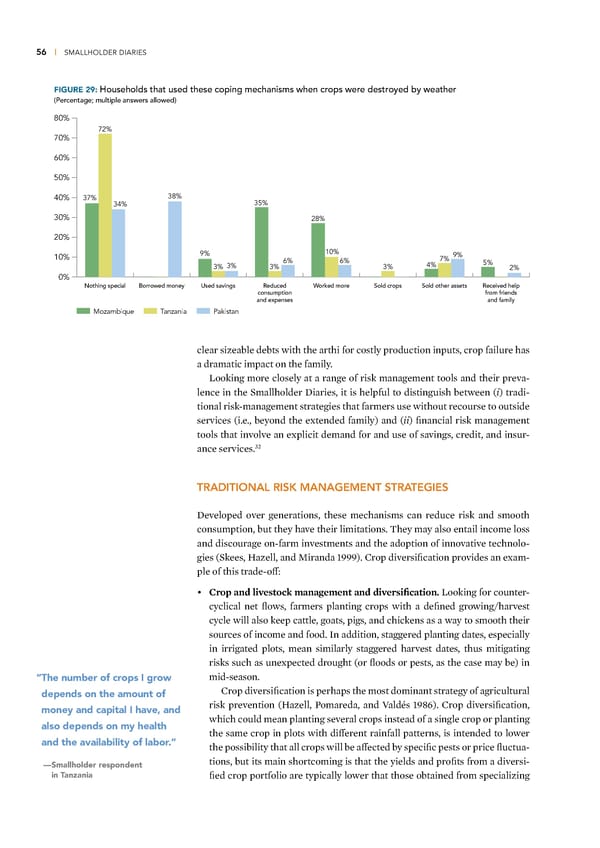56 | SMALLHOLDER DIARIES FIGURE 29: Households that used these coping mechanisms when crops were destroyed by weather (Percentage; multiple answers allowed) 80% 72% 70% 60% 50% 40% 37% 38% 34% 35% 30% 28% 20% 10% 9% 10% 9% 6% 6% 4% 7% 5% 3% 3% 3% 3% 2% 0% Nothing specialBorrowed money Used savings Reduced Worked more Sold crops Sold other assets Received help consumption from friends and expenses and family Mozambique Tanzania Pakistan clear si—eable debts with the arthi for costly production inputs, crop failure has a dramatic impact on the family ƒooing more closely at a range of ris management tools and their preva- lence in the Smallholder ‰iaries, it is helpful to distinguish between (i) tradi- tional ris-management strategies that farmers use without recourse to outside services (ie, beyond the extended family) and (ii) financial ris management tools that involve an explicit demand for and use of savings, credit, and insur- Ÿ‘ ance services TRADITIONAL RISK MANAGEMENT STRATEGIES ‰eveloped over generations, these mechanisms can reduce ris and smooth consumption, but they have their limitations Œhey may also entail income loss and discourage on-farm investments and the adoption of innovative technolo- gies (Sees, Ha—ell, and –iranda …žžž) †rop diversification provides an exam- ple of this trade-off • ”rop and liestocƒ management and diersification ƒooing for counter- cyclical net flows, farmers planting crops with a defined growing¤harvest cycle will also eep cattle, goats, pigs, and chicens as a way to smooth their sources of income and food €n addition, staggered planting dates, especially in irrigated plots, mean similarly staggered harvest dates, thus mitigating riss such as unexpected drought (or floods or pests, as the case may be) in “ The number of crops I grow mid-season depends on the amount of †rop diversification is perhaps the most dominant strategy of agricultural money and capital I have, and ris prevention (Ha—ell, omareda, and §aldés …ž¡¢) †rop diversification, also depends on my health which could mean planting several crops instead of a single crop or planting the same crop in plots with different rainfall patterns, is intended to lower and the availability of labor.” the possibility that all crops will be affected by specific pests or price fluctua- —Smallholder respondent tions, but its main shortcoming is that the yields and profits from a diversi- in Tanzania fied crop portfolio are typically lower that those obtained from speciali—ing
 Financial Diaries with Smallholder Families Page 71 Page 73
Financial Diaries with Smallholder Families Page 71 Page 73